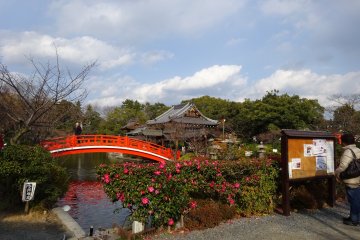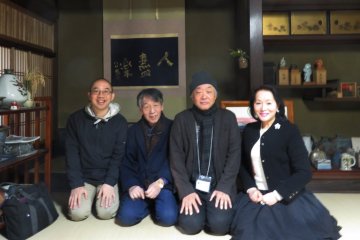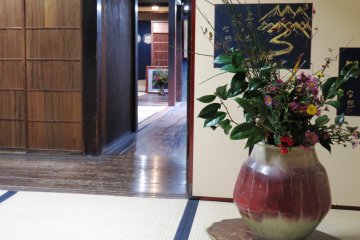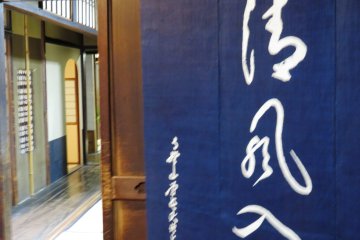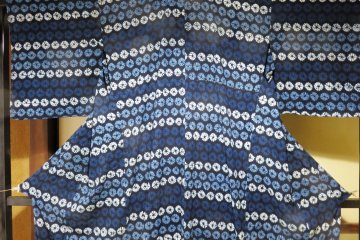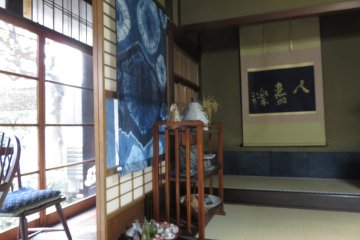Indigo dying, known as Aizome is a labor of love using oxygen, water, bacteria, and constant turning of the fermented leaves. In some ways making indigo dye is like making sake, with a careful eye to fermentation and adjusting the temperature, like willing a cocoon to transform into a butterfly at just the right time.
Utsuki san the owner of Aizenkobo personally inspects the best indigo for his workshop. He tells me there used to be lots of indigo growers but now there are only five in Tokushima and one in Hyogo. The use of natural dyes gives stability and strength, but chemical production results fade over time. The natural dye doesn't mix with water so it doesn't wash away the color but actually improves over time. For cotton, the fabric needs to be dipped 100 times for the dye to reach the right color and quality, while it is 200 times for silk.
A story of renewal
When I asked Utsuki san whether he has confidence in the future of indigo, his wife thought deeply and told me a story. “I was born to an established family and did not know the value of money. Things came naturally to me without effort”, she reflected. However, even from an early age, she knew high-quality artwork and understanding customer needs were important. “When I married an artist and worked in his small Obi or kimono accessory shop I came to see that sales were dropping. Many Japanese these days don't know how to put on a kimono by themselves. I knew we had to change. So gradually we made more indigo in western apparel and less of the obi”. Design, she came to learn, was the key to the future of indigo. By learning about and responding to changes in customer tastes, she believed that indigo textiles may have a chance in the future.
Whilst I was listening to Mrs. Utsuki telling her story of transformation, there was a part of me that thought, maybe she has told this story before, despite the way her eyes lit up and the animated and passionate tone she used. It was like, for every retelling of her story, a way for her to cultivate it anew, to make something that happened three decades ago as if it just happened yesterday. It was her way to feel young again, to celebrate her daring, to risk it all for an uncertain future, and how it all paid off, many times over. It was like a creation story, a story of rebirth and regeneration.

Aizenkobo – how it came to be
From humble beginnings, this couple took the long road to build the business. There was no advertising, but thirty years of word-of-mouth recommendations have seen the quality of their work being acclaimed from far and wide, such as a permanent exhibit in the British Museum, to a legion of discerning buyers from America to Australia. For it is in the wearing of their clothing that their qualities come to life. Its anti-bacterial and fire-resistant qualities are healing in ways that most people don't know about.
It was only ten years ago that this third-generation artisan started their own website, documenting their transformation from an obi maker to one that advocates sustainability and appreciation of life in all its forms. As recently as 2011, most of its customers were Japanese. These days, it is the other way around, with 90 percent of its clientele from overseas, and discerning customers from places like New York and Melbourne make frequent visits here.
The naming of Aizenkobo
The word Aizenkobo literally means Indigo dying workshop, but the kanji speaks more to the essence of this place, Ai meaning love or esteem, as in the favorite dye workshop.
Aizenkobo was named by the famous writer Junichiro Tanizaki in February 18, 1929, his framed autograph taking the pride of place in the gallery. He wrote “in Praise of shadows” an essay about Japanese aesthetics and mindfulness. Like Moon viewing, the falling of the cherry blossoms, the shadows from a Noh mask creating different expressions, the patterns of grain in old wood, or the sound of rain dripping from eaves.
To readers who are more familiar with Western Art, both light and shadow are necessary to display beauty, like Chiaroscuro in Dutch and Flemish Art, or the grain of the wood accentuated by the shadow caused by the relief of the grain.
Ma or shadows is a theme in Japanese art and fashion, as seen in the Kyoto Fashion Museum. It is fitting that Japanese aesthetics, the interplay between light and shadow, sound and silence, is seen in the naming of this house, as well as the design of the jackets and clothes made with Aizome. Shadows can create a dream-like experience, like a stolen glimpse of a geisha that is at once past, as if it never happened, or the flicking of candlelight, creating a playful dance between light and shadow.
The concept of ma is also used in music. It is through the silence of the reverberation of the bells that you can reflect on its sound, a space where the distractions in your mind are shut out. The negative space exists in music as well as art. When you enter into the silence, there is a special space where you can encounter art itself.

The philosophy behind her design
Mrs. Utsuki studied tea ceremony and ikebana since she was six and was one of the youngest people to obtain her tea license in her teens. While this seems like an absurdly young age to study, it should be noted that traditionally, children start on June 6th of the sixth year, a tradition known as 6-6-6, a hallmark of a traditional Kyoto education.
With ikebana, the flowers and their seasons are only temporary, much like the concept of Ichi-go Ichi-e This concept of passing beauty is reflected in the textile and clothing design. We don’t know what will happen tomorrow, so enjoy each moment you have now. This is the philosophy behind her work.
Her idea of innovation is one of lifelong learning, and even now she is teaching natural medicine. Her humility is touching despite her knowing the Prime Minister’s wife, or that her husband’s work takes the pride of place in the British Museum.
Even in kindergarten, she wanted to be stylish and have her photos taken. Some of her designs could come from flower arrangements, as she trained in ikebana as a teacher from a young age. She had an eye for fashion and style since she was young, even though her father was a strict traditionalist, an advisor to the Heian Shrine. She proudly tells me that Alex Kerr wears the indigo jacket and scarf that she designed every time he visits her.

In essence, a summary
Indigo is only one element of Kyoto Culture. In the garden or ecosystem of Kyoto, clothing, like tea utensils or dolls, or any other handicraft, is there like a supporting act. The key players would be the geisha or samurai, or the daimyo or the emperor. What is their future? How can that be refreshed for the future?
Of course, as it takes a lifetime to just master one handicraft, one element of Kyoto culture, so the whole community needs to come together to make it happen. In Kyoto, each element comes together, like a play with many supporting parts.




